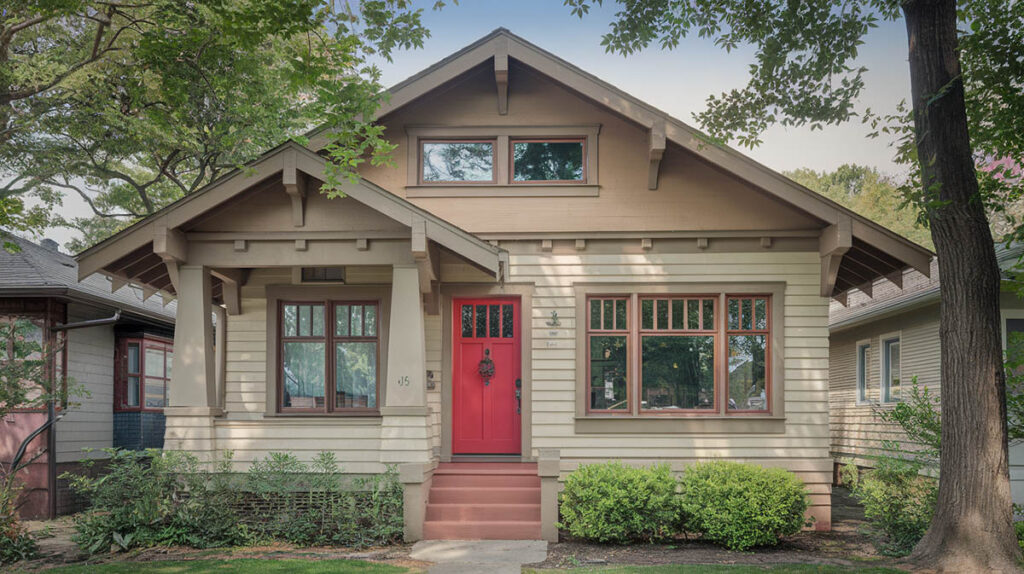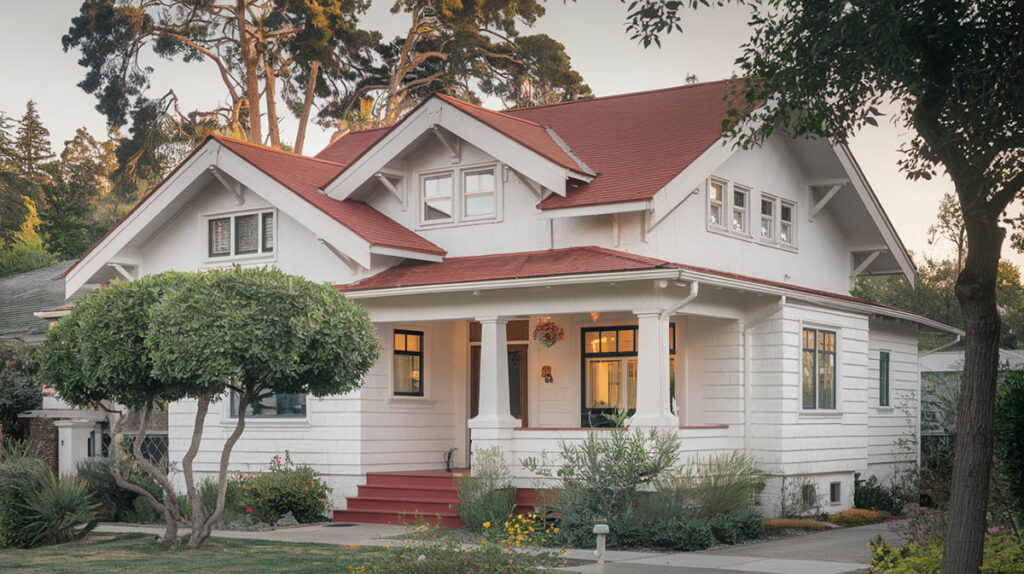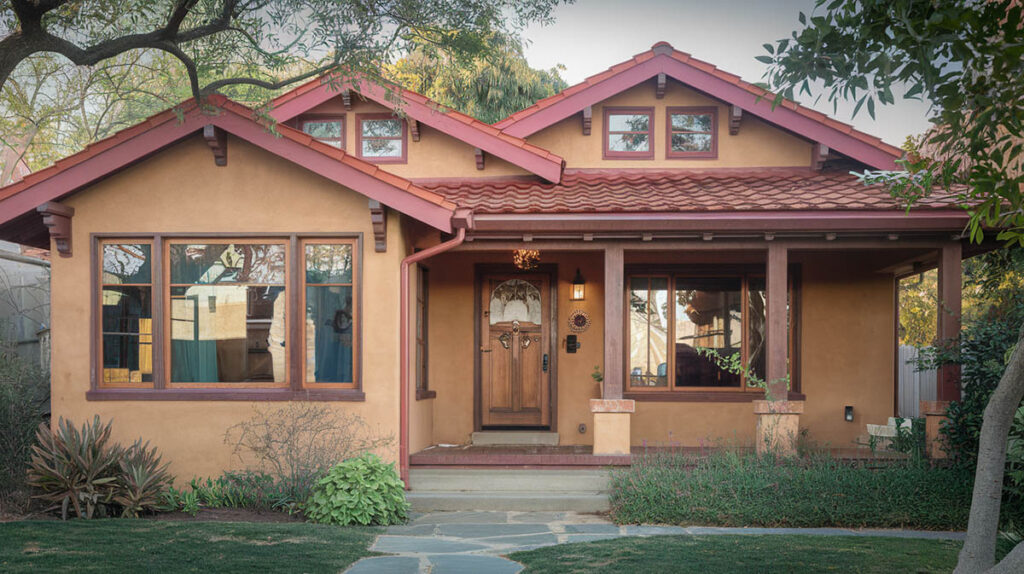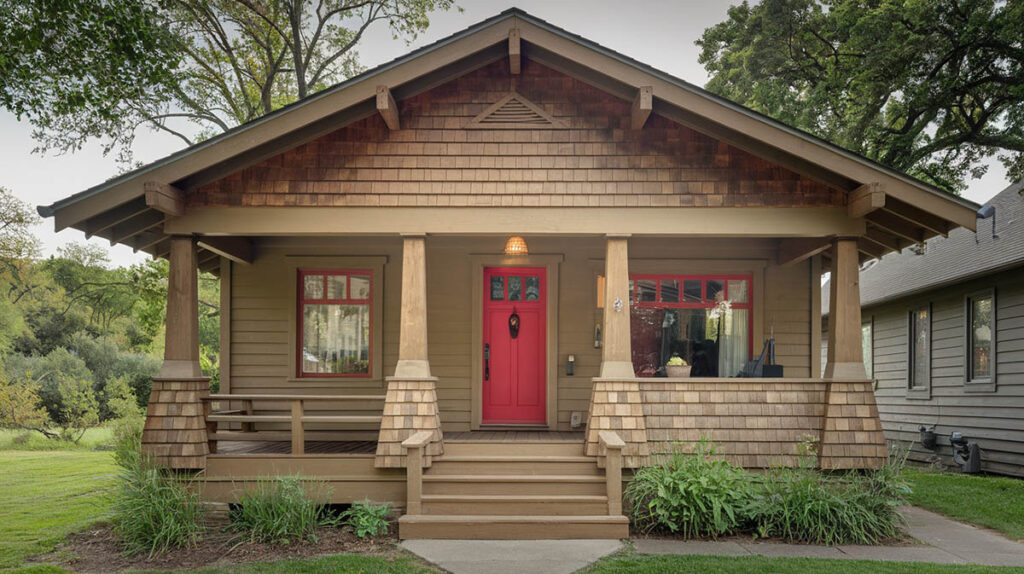How to Choose the Perfect Bungalow House Plan

Bungalows – charming, practical, iconic. These single-story homes have been beloved for over 100 years, and for good reason. Originally built in colonial India to give British folks relief from the heat (the word comes from the Hindi “bangla” or “belonging to Bengal”), the bungalow house plan blends coziness and beauty with smart design.
Key Characteristics of Bungalow House Plans
Some of the features that make bungalows so distinctive are their sweeping front porches, tapered columns, and low-pitched roofs with overhangs and decorative eaves. The curb appeal from its wide front porch serves as a functional outdoor living room. And inside, built-in cabinetry and woodwork add warmth while offering storage space.
The layout focuses on open concept spaces – flowing kitchen, dining room, living room to maximize the feel of the available square footage. Abundant access points and windows reinforce the connection between indoor and outdoor, embracing natural light and fresh air.
It’s no wonder bungalow floor plans remain a beloved staple – these homes merge charm and function into a comfortable, livable package. Their practical single-story layout, iconic architectural details like the front porch, and open concept interior cater to modern living. No matter the trends, bungalows will always represent efficient and beautiful design.
Types of Bungalow Styles
While the overall look is similar, there are several sub-genres of bungalows to consider. Here’s some of the options:
Craftsman Bungalow
Craftsman bungalows spotlight exposed beams, rich woodwork, and natural materials that give off an aura of quality craftsmanship. You’ll find lovely built-in shelving, window seats to gaze at the outdoors, and stunning stone fireplaces flanked by custom cabinetry. It’s a style that feels at one with its wooded surroundings.
California Bungalow

With their wide, welcoming verandas, numerous windows ushering sunlight indoors, and seamless indoor-outdoor living spaces, California bungalows epitomize early 20th century architecture adapted for the warm climate. Hugely popular as the American Arts and Crafts movement drifted West at the turn of the century, these homes showcase hallmarks of the style – low-slung profiles, gently sloping roofs with overhanging eaves, and natural materials like stone and brick. Exteriors typically sport textured stucco and clay tile rooftops harkening to the region’s Spanish and Mexican architectural roots.
Both aesthetically pleasing and practical, drought-tolerant gardens require little maintenance while lending color and texture. Bungalow floorplans embrace the notion of blurring boundaries between interior rooms and the outdoors with dynamic sightlines. Multiple windows, sleeping porches, and terraces expanding living areas speak to the California lifestyle of relaxing and entertaining under sunny skies.
Chicago Bungalow
With their brick construction, full basements and plentiful windows, Chicago bungalows were built to stand up to tough Midwestern winters. Sturdy masonry exteriors sport prairie-style limestone accents, contrasting beautifully with the large picture windows. Inside, the homes feel warm, welcoming and able to withstand even the harshest lake-effect blizzard.
Prairie Style Bungalow
Prairie bungalows apply Frank Lloyd Wright’s hallmarks to the traditional form. Horizontal lines, flat roofs, and geometric details emphasize continuity with the landscape, while banks of windows and open floor plans fuse interior spaces with the outdoors. Flat window planes and geometric patterns define the facade in a modern, stylish way.
Modern Bungalow
Modern bungalows incorporate up-to-date amenities and sustainable elements while maintaining the humble scale and connection to nature that define these practical homes. Smart home technologies and energy-efficient materials merge with timeless qualities for contemporary appeal. But they maintain the cozy charm and smart use of space intrinsic to bungalow living. These sustainable homes have an efficient footprint focused on quality over quantity.
Choosing A Bungalow Plan Based On Family Size
If you’re single or a couple without kids, a home in the range of 800-1,200 square feet is generally enough space without feeling too cramped. The downside is it doesn’t give you any room for expansion later on. This layout typically gives you 1 to 2 bedrooms and 1 to 2 bathrooms.
For a small family of 3-4 people like parents with 1-2 kids, aim for 1,200-1,800 livable square feet. This gives 2-3 bedrooms for everyone plus 2 bathrooms. Be sure to have areas specifically for the kids to play and do homework.
Larger families with 5 or even more should go for at least 1,800-2,500 square feet and 3 to 4+ bedrooms. With all these people, you’ll want plenty of room for storage. Multiple living areas give kids their own spaces for toys and media while parents have quiet zones. The extra bedroom(s) let kids have their own rooms as they grow. 2-3 bathrooms prevent morning rush hour traffic jams.
The number of people you need to house now and in the upcoming years determines how much space your home requires.
Choosing A Plan Based On Your Budget

Before buying a plan and calling the contractor, it’s wise to set a realistic budget. This will determine the size and features your new home can offer.
First, factor about 20-30% of total costs toward buying your lot. Then, construction runs $150-300 per square foot on average. Of course regional labor and material rates cause fluctuations. You’ll also need 5-10% of building expenses for grading, drainage, landscaping and the like to get your lot ready for move-in day. And finally, an architect to draw plans and secure permits will set you back around 3-7% more.
Once settled into your new bungalow, ongoing monthly costs persist. Make no mistake, your mortgage lender, property tax collector and home insurer will come calling! Also factor electricity, gas, water, garbage pickup and other utilities. Then there’s long-term maintenance to keep your bungalow looking its charming best over decades of use. Elements like the roof, siding, windows and landscape care require timely attention and investment.
The key is outlining a thorough budget upfront to strategize fitting the bungalow features you want most into available funding. This helps select an ideal lot size and design plan that brings your dream home to life! What questions might you have on mapping out numbers for your new bungalow? I’m glad to clarify any uncertainties before you break ground.
Benefits of Choosing a Bungalow Style House
Opting for a bungalow home design offers homeowners many practical benefits for comfortable living. With its single-story layout eliminating stairs, bungalows enable both aging residents and young families to easily navigate their home. Doorways are wide and open floor plans accommodate wheelchairs or walkers if needed, making bungalows ideal for aging in place.
Energy Efficiency – These homes also conserve energy thanks to their compact footprint, broad eaves for passive solar protection, and simple roof line well-suited for solar panels.
Easier Maintenance – Easy roof access supports lower-risk maintenance like gutter cleaning or minor repairs. And the simplified roof with fewer valleys and intersections reduces potential for leaks over time. Beyond practical perks, bungalows blur the line between indoor and outdoor living with multiple access points and large porches that expand usable living space.
Indoor Outdoor Living – By effectively bringing the outdoors in, bungalows encourage residents to embrace fresh air and an active lifestyle. The single-story design, accessibility, efficiency, easy upkeep, and indoor-outdoor flow – bungalows package ideal features for comfortable, modern living.
Bungalow Design Considerations
When designing a bungalow home, you need to think carefully about the lot size and layout to make it work. Unlike towering two-story houses, these horizontal homes spread out, so you’ll likely need a wider lot to give it enough breathing room within the setback requirements. The orientation matters too – you want to position it just right to let in ample sunlight and maintain privacy.
Though the footprint may be smaller, smart space planning keeps bungalows highly functional. Create multipurpose rooms that can change as needs evolve – say, a living area that could convert to a guest room down the road. Incorporate built-in storage to prevent clutter while keeping necessities at arm’s reach. Strategically place windows and doors to facilitate intuitive traffic flow from space to space.
Potential Challenges of Living In a Bungalow
Living in a small home like a bungalow poses some unique challenges, but creative solutions can transform limited space into comfortable living. The main issue most deal with is a lack of square footage. Strategically incorporating built-in storage and furniture is a savvy way to maximize every inch.
Consider opening up the space by adding vaulted ceilings too. They draw the eye up, creating the illusion of more room. If feasible, finish off the basement for bonus living area. And don’t forget the outdoors! Building a deck or patio essentially adds extra “rooms” for lounging and entertaining.
Privacy is another common concern in cozy bungalows. The good news is you don’t have to sacrifice that indoor-outdoor flow these homes are known for. Carefully position windows to allow light while avoiding direct sightlines to neighbors.
Landscaping also goes a long way towards delineating private zones. Plant tall bushes or trees to carve out secluded spots. For bathrooms and bedrooms, choose frosted window glass or smart window placements high on the wall. Within the floorplan, think intentionally about which rooms go where. Place public living areas at the front of the home, keeping private rooms towards the back for added seclusion.

Modern Bungalow Customizations
On the inside, open up a modern bungalow with an airy, open concept kitchen featuring a central island and casual eating bar. Create a relaxing master suite with a spa-like bathroom for long soaks in the tub. Carve out dedicated office space or a flexible room to suit your changing needs. Integrate smart home technology for total home control. Choose energy-efficient appliances and systems to save resources.
On the exterior, maintain the charming bungalow architectural details while adding personal touches. Construct a mixed material façade combining natural stone, brick accents and horizontal siding. Design a custom wraparound porch with built-in seating for relaxation. Select a historically-appropriate, nature-inspired color scheme. Landscape with native plants that highlight the home’s beauty.
Building and Construction
New construction typically takes 6-8 months. Carefully consider foundations, excavation needs and basement possibilities. Use quality building materials for long-lasting durability. Install proper insulation and weatherization. Incorporate modern systems while maintaining period-appropriate details.
Maintenance and Upkeep
Perform regular maintenance to keep your bungalow looking its best. Clean gutters seasonally and maintain wood elements to prevent deterioration. Check drainage and run HVAC system tune-ups. Update weatherstripping and insulation as needed. With proper care, your modern bungalow will provide enjoyment for years to come.
Final Word
Bungalow house plans have stood the test of time by artfully blending functionality, comfort, and architectural beauty into timeless homes. Their historical charm and practical layouts keep them relevant for modern living needs. When undertaking a bungalow project, tap professionals who appreciate both the rich history and current demands these homes must meet.
Whether you’re planning new construction or renovating an existing bungalow, the right team will help honor the past while optimizing for present and future enjoyment. By working with experts well-versed in bungalow history and modernization, you’ll create a warm, lovely home your family can enjoy for years to come.
